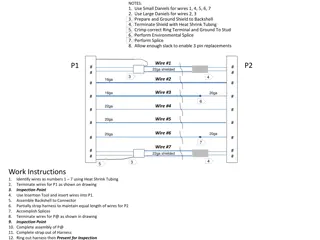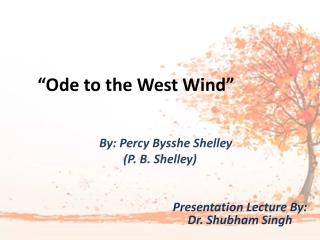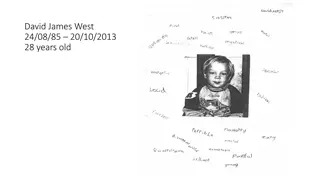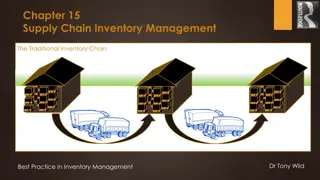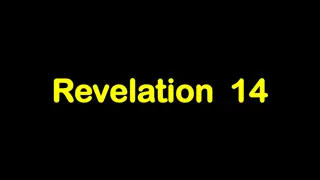Consequences of Barbed Wire Introduction in the Wild West
The introduction of barbed wire in the West in 1874 had significant consequences. It caused conflicts between homesteaders and ranchers and resolved the issue of a lack of timber on the Great Plains. The conflicts arose due to fencing disputes, while the lack of timber problem was addressed by the effective and cheap fencing solution provided by barbed wire.
Download Presentation

Please find below an Image/Link to download the presentation.
The content on the website is provided AS IS for your information and personal use only. It may not be sold, licensed, or shared on other websites without obtaining consent from the author. Download presentation by click this link. If you encounter any issues during the download, it is possible that the publisher has removed the file from their server.
E N D
Presentation Transcript
Question 1 Explain twoconsequences of How to answer consequence questions: The question wants you to explain the RESULTS of something. What difference did it make? Use phrases such as as a result or the effect of this was .
MODEL ANSWER Explain two consequences of the introduction of barbed wire in the West (1874) (8 marks) Consequence 1: A consequence of homesteaders use of barbed wire was that it caused problems for the cattle industry. For example homesteaders land claims usually included a water source, fences often prevented cattlemen s open-range cows from reaching water. Many cattlemen found this unfair and would threaten violence or damage to crops if the fences weren t removed. Some cattlemen even cut the barbed wire fences themselves so that their cows could drink. Therefore, as a direct consequence of barbed wire there was conflict between homesteaders and ranchers. This became worse when ranchers moved to smaller, enclosed ranches; now ranchers used it to fence off their winter pastures, often preventing new homesteaders gaining access to water sources for their livestock. Consequence 2: Another consequence of the introduction of barbed wire in 1874 was that it solved the problem of a lack of timber on the Great Plains. For instance, there were very few substantial trees on the Great Plains when homesteader s arrived and importing timber to use for fencing was very expensive. The homesteaders needed to fence their livestock to keep them away from other animals which could be carrying disease. They also needed to protect their crops from wild animals such as the buffalo. The effect of barbed wire was that now large areas of land could be fenced effectively and cheaply without the need for large amounts of timber. This would save the homesteaders money but also allow them to increase the success of their farms.
POINT You should spend 10-12 minutes on this answer. EVIDENCE EXPLAIN You should keep your answer brief (no more than space on exam paper). This will make sure you have enough time for later questions worth more marks. POINT EVIDENCE EXPLAIN
Question 1 - Mark Scheme Mark each consequence separately (up to 4 marks for each consequence) Level Mark Descriptor 1 1-2 Simple or generalised comment is offered about a consequence. Generalised information about the topic is included, showing limited knowledge and understanding of the period. 2 3-4 Features of the period are analysed to explain a consequence. Specific information about the topic is added to support the explanation, showing good knowledge and understanding of the period.
Question 2 Write a narrative account analysing This prompted This led to Outcome/Finish Start/Event 1 Event 2 How to answer narrative account questions: The question wants you to write a narrative explaining how events led to an outcome.
Linking words/phrases You should spend 15 minutes on this answer. The student has identified the first events in their narrative. Giving accurate dates for events helps structure the narrative. Aim to write an organised answer, putting events in the right order and showing how one connects to the next. Your narrative should have a clear beginning, middle and end. Links are made between key events, e.g. the Bozeman Trail broke the Fort Laramie Treaty, and the consequences that followed from this. By writing linking phrases like in order to , despite and as a consequence , the student has signposted their analysis.
You are given two information points as prompts to help you. You do not have to use the prompts and you will not lose marks by leaving them out. Always remember to add in a new point of your own as well to gain the higher marks.
MODEL ANSWER Write a narrative account analysing the key events in the years 1851-66 that led to the beginning of Red Cloud s War. You may use the following in your answer: The Fort Laramie Treaty (1851) The discovery of gold in Montana You must also use information of your own. (8 marks) The Fort Laramie Treaty of 1851 was agreed between the Sioux (and other tribes) and the US government. In return for the Plains Indians guaranteeing safe passage for whites travelling along existing trails, the US government agreed which lands belonged to the Plains Indians forever , and promised to protect these lands from any trespassing. However, when gold was discovered in Montana in 1862, whites rushed to the new gold fields. In 1863, the Bozeman Trail was set up through Sioux territory. The Bozeman Trail broke the Fort Laramie Treaty, but the US Army did not protect the Sioux s lands from white trespassers. As a result of this betrayal of the Fort Laramie Treaty, furious Sioux warriors demanded that whites turn back. They also attacked them. This led to the US government saying that the Plains Indians had broken the Treaty too. Because of this, in 1865, the US Army was ordered into the area to protect white travellers. In order to try to get what it wanted from the Sioux without a fight, the US government organised a peace council in 1866. The government negotiators wanted white settlers to be allowed safe passage along the Bozeman Trail, and for new forts to be built along the trail to protect Plains Indian lands. Red Cloud was at the council, speaking as a chief of the Oglala Sioux. He refused to allow the Bozeman Trail or the forts. His experience of the Fort Laramie Treaty showed him that the government was not to be trusted. Despite his refusing to allow the forts, Red Cloud learned that soldiers had started building them anyway. As a consequence, Red Cloud left the council, certain that the Sioux must defend their lands by force. Red Cloud s first attack was at a newly- built fort, leading to Fetterman sTrap: the US Army s worst defeat against the Plains Indians to that point. Red Cloud s War had begun.
Question 2 - Mark Scheme Mark Descriptor Level 1 1-2 A simple or generalised narrative is provided; the account shows limited analysis and organisation of the events included Limited knowledge and understanding of the events is shown. 2 3-5 A narrative is given, showing some organisation of material into a sequence of events leading to an outcome. The account of events shows some analysis of the linkage between them, but some passages of the narrative may lack coherence and organisation. Accurate and relevant information is added, showing some knowledge and understanding of the events. Maximum 4 marks for answers which do not go beyond aspects prompted by the stimulus points A narrative is given, which organises material into a clear sequence of events leading to an outcome. The account of events analyses the linkage between them and is coherent and logically structured. Accurate and relevant information is included, showing good knowledge and understanding of the key features or characteristics of the events. No access to Level 3 for answers which do not go beyond aspects prompted by the stimulus points 3 6-8
Question 3 Explain two of the following: The importance of ... to The importance of ... to The importance of ... to How to answer importance questions: The question wants you to explain the importance of events and developments. You have a choice of two out of three options. Take time to make the choice. Before you decide, be clear what you have to explain: the question is always worded as Explain the importance of for
It is a good idea during revision to practice identifying the importance of key events for something: what did they affect or lead to? Ask yourself: What difference did they make to it? or Why did they matter? Be clear about your reasons for saying something is important. This answer links directly to explaining the importance of the railroads for changing the Plains Indians way of life and the ways in which it changed.
MODEL ANSWER (for this example only one of the TWO answers needed are shown) Explain two of the following: The importance of the railroads for changes in the way of life of the Plains Indians. The importance of the wagon trails for the early settlement of the West. (16 marks) The railroads were an important part of encouraging settlement and therefore challenged the Plains Indians way of life in their traditional areas. The 1862 Pacific Railroad Act gave railroad companies grants of land surrounding the railroad routes. This land had previously been behind the Permanent Indian Frontier and was now sold to settlers. When finished, the railroads enabled more settlers to travel to the Plains and made the transport of machinery and raw materials possible. This further encouraged settlers to farm in the Great Plains and settlers started to demand more land. This would change the way of life of the Plains Indians because the tribes had less access to hunting grounds and settlers often used barbed wire to fence in their homesteaders, further restricting their traditional nomadic way of life. Another reason the railroads had a big impact on the Plains Indians way of life was because they bought white hunters and skinners to the Plains. The Indians relied on the buffalo for survival, however these individuals began to quickly reduce the buffalo population. Buffalo hides were transported by train from the Plains to factories for processing to make skinners huge amounts of money. Whilst rich white Americans would use the trains to partake in organised pleasure hunts of the northern and southern buffalo herds. As a result of this the way of life for the Plains Indians would change because without the buffalo to hunt, Plains Indians lost their source of food, clothing and shelter. They lost the nomadic life of hunting the buffalo herds, and men lost their role as hunters. Their lives changed towards having to rely on government handouts of food, and to farming and ranching instead of hunting. The railroad also brought conflict between gold prospectors and Plains Indians, resulting in violence. For example railroads were used by gold miners who trespassed on Plains Indian hunting grounds (e.g. in the Black Hills in Dakota) and were even used to transport troops who gave the prospectors protection from Indian attack. The Plains Indians were forced by the US Army to stay on their reservations to avoid conflict with settlers. These restrictions were very difficult for nomadic people who were now forced onto reservations, losing their independent way of life.
POINT POINT You should spend 25 minutes on this answer. EVIDENCE EVIDENCE EXPLAIN EXPLAIN This question is worth half your marks for the whole Period Study. Make sure you have kept 25 minutes of the exam time to answer. In the exam you will have two separate answer sheets in the booklet for this question, one for each of the two answers you give in Question 3. Make sure you indicate at the start of each answer which point you are addressing; you are prompted to do this. POINT EVIDENCE EXPLAIN
Question 3 - Mark Scheme Mark each response separately (up to 8 marks for each explanation of importance) Level Mark Descriptor 1 1-2 A simple generalised answer is given, showing limited development and organisation of material. Limited knowledge and understanding of the topic is shown. 2 3-5 An explanation is given, showing an attempt to analyse importance. It shows some reasoning, but some passages may lack coherence and organisation. Accurate and relevant information is added, showing some knowledge and understanding of the period. 3 6-8 An explanation is given, showing analysis of importance. It shows a line of reasoning that is coherent and logically structured. Accurate and relevant information is included, showing good knowledge and understanding of the required features or characteristics of the period studied.









